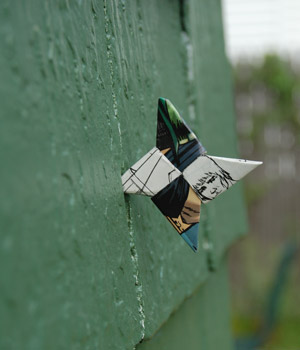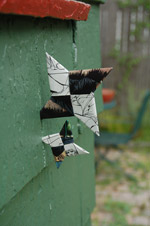

 |
 |
 |
 |
 |
 |
 |
 |

Rebecca Garcia (photo)
Remember in grade school when we used to make little paper footballs and flick them through a friend's upright fingers? Remember how the teachers used to freak out about how we'd put someone's eye out that way? Here's an improvement—it'll take out more than an eye.
Dedicated to the immortal memory of the great Bruce Lee.
Suggested Watching
Difficulty
The Sagen-Hawkins Congruence
Click here for definitions of difficulty levels.
Finished Measurements
Will vary depending on the size paper you use.
Materials
- Two pages from a Green Hornet comic book (try to make sure they feature Kato)
- Your hands (which don't need to be registered as lethal weapons...yet)
Design Notes
For those who freak out about the destruction of any sort of printed material, but who may be particularly sensitive to the destruction of a comic book, I assure you I used one of this year's free books from Free Comic Book Day, held May 1, 2010. These books are so massively printed and widely available (on FCBD; afterwards? Perhaps not so much.) that there are still a lot of them out there, and the future value is unlikely to be more than what I originally paid for them. Really, this is true of most comic books.
Really have a problem with cutting up a comic book? Or you really want to use pages from a book that actually has value? Never fear: photocopy or scan the pages you want to use. You know what's great about this (besides not ruining a perfectly good book)? You can scale the page to the size you want. It's nice to have a variety of different sizes of throwing stars.
Alternatively, comic book stores usually have a large assortment of back issues. Check these out, and look especially for issues in series that may be incomplete. These are ideal -- they are old enough that the entire story has probably been collected into a trade paperback (aka "graphic novel"), and no one is likely to provide a home for these sad little orphans. You are actually doing them a favor by breathing new life into these long-forgotten comic books and transforming them into something far different (though hopefully related) to their origins.
My husband enthusiastically encourages all of you to please please please use your discarded comic books for origami, collage, paper hats, napkins, biodegradable seedling pots, and bird cage liners. It will improve the odds that his collection of tens of thousands of comic books will actually gain some value.
Step 1
Comic book pages are most often rectangular. By whatever means (cutting, folding and tearing, gnawing; I leave this up to you), transform this rectangle to a square. You want even sides and smooth edges, just like with regular origami paper.
Place your newly created origami paper with the wrong side facing up. The wrong side will be on the inside of the finished piece.
Step 2
Fold your first square of paper in half to makes wrong sides touch, and then unfold it.
Using the center crease just created as a guide, fold the right and left edges in to the center, also to make wrong sides touch. Fold up on that center crease, so that the right and left edges are sandwiched in the middle.
Your paper should now be 1/4 the width it originally was, with the "center crease" on the left-hand side, and the right side of your paper should show no matter how you flip it over. Orient it lengthways (landscape) and fold it in half so short sides touch. Unfold it back out again to create a new center crease to use as a guide in Step 3.
Repeat Step 2 for your second square of paper.
Step 3
Back to your first square of paper, now a rectangle. Orient it lengthways (landscape) and to the left of the center guide crease, fold the top edge down to run parallel to the center guide crease. To the right, fold the bottom edge up to run parallel to the center guide crease. This creates something that looks like a flat, right-leaning twist.
Repeat Step 3, but mirrored, for your second rectangle (i.e., to the left of center, fold the bottom edge up; to the right of center, fold the top edge down). This creates a flat, left-leaning twist.
From here on out, make sure that your two pieces of paper always mirror each other, or else they won't attach correctly to each other in the end.
Step 4
Flip your right-leaning twist over so that the folded-in edges are touching your tabletop and orient it so that the "twisted" middle section is parallel to you. Your twist now leans left.
Now fold the outside edge of the top section (the bit perpendicular to you) down to meet the top of the middle section. Repeat to bring the outside edge of the bottom section up to meet the bottom of the middle section. If you turn this 45° clockwise, you'll see it now looks rather like either a backwards Z.
Repeat Step 4 on the left-leaning twist, to get a non-backwards Z.
Step 5
Hold your backwards Z in your left hand and your proper Z in your right hand.
Flip over the backwards Z in your left hand.
Turn the forwards Z in your right hand 90° counter clockwise and place it on top of the one in your left hand to form a kind of cross. Your left-hand Z is now on the bottom, and your right-hand Z is now on the top.
Step 6
Fold in and tuck the points of the bottom Z into the twist of the top Z. Your Zs are now joined together.
Flip the entire piece over and repeat Step 6.
Congratulations, you have made a weapon out of paper! (Seriously, you probably won't kill anyone with this, but you could easily hurt someone. Please ninja responsibly: don't go ninjain' nobody who don't need ninjain'.)
Don't like the idea of a weapon? Pierce a hole in one point of the star, thread some string through it, and you have a star ornament. Q.E.D. Hang it on a Yule tree or in a window or around your dog's neck. Whatever. You're creative, you'll find a use for it.
It could be a handy object to throw at your tv (probably an older, CRT tv only; it might actually damage an LCD screen) when Gossip Girl "accidentally" comes on.
About
 contact Rebecca:
• legal info
contact Rebecca:
• legal info
![]()
home • antifesto • this issue • archive • submit • errata • masthead • contact us • legal
